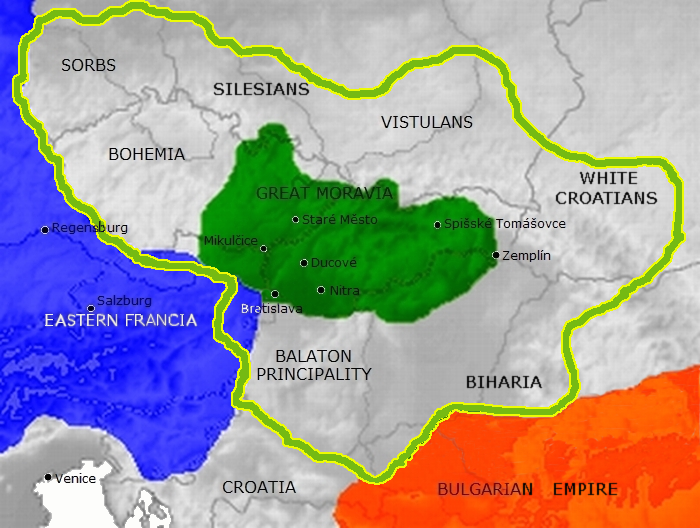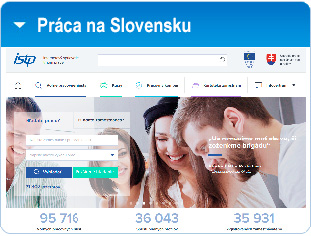The era of Great Moravia (830–896)
 History of Slovakia
History of Slovakia
The era of Great Moravia (830–896)
Central Europe in the 9th century. Eastern Francia in blue, Bulgaria in orange, Great Moravia under Rastislav (870) in green. The green line marks the borders of Great Moravia under Svatopluk I (894). Please note that some of the borders of Great Moravia are under debate
Great Moravia arose around 830 when Moimír I unified the Slavic tribes settled north of the Danube and extended the Moravian supremacy over them. When Mojmír I endeavoured to secede from the supremacy of the king of East Francia in 846, King Louis the German deposed him and assisted Moimír's nephew, Rastislav (846–870) in acquiring the throne. The new monarch pursued an independent policy: after stopping a Frankish attack in 855, he also sought to weaken influence of Frankish priests preaching in his realm. Rastislav asked the Byzantine Emperor Michael III to send teachers who would interpret Christianity in the Slavic vernacular. Upon Rastislav's request, two brothers, Byzantine officials and missionaries Saints Cyril and Methodius came in 863. Cyril developed the first Slavic alphabet and translated the Gospel into the Old Church Slavonic language. Rastislav was also preoccupied with the security and administration of his state. Numerous fortified castles built throughout the country are dated to his reign and some of them (e.g., Dowina, sometimes identified with Devín Castle) are also mentioned in connection with Rastislav by Frankish chronicles.
During Rastislav's reign, the Principality of Nitra was given to his nephew Svatopluk as an appanage. The rebellious prince allied himself with the Franks and overthrew his uncle in 870. Similarly to his predecessor, Svatopluk I (871–894) assumed the title of the king (rex). During his reign, the Great Moravian Empire reached its greatest territorial extent, when not only present-day Moravia and Slovakia but also present-day northern and central Hungary, Lower Austria, Bohemia, Silesia, Lusatia, southern Poland and northern Serbia belonged to the empire, but the exact borders of his domains are still disputed by modern authors. Svatopluk also withstood attacks of the nomadic Magyar tribes and the Bulgarian Empire, although sometimes it was he who hired the Magyars when waging war against East Francia.
In 880, Pope John VIII set up an independent ecclesiastical province in Great Moravia with Archbishop Methodius as its head. He also named the German cleric Wiching the Bishop of Nitra.
After the death of King Svatopluk in 894, his sons Mojmír II (894–906?) and Svatopluk II succeeded him as the King of Great Moravia and the Prince of Nitra respectively. However, they started to quarrel for domination of the whole empire. Weakened by an internal conflict as well as by constant warfare with Eastern Francia, Great Moravia lost most of its peripheral territories.
In the meantime, the Magyar tribes, possibly having suffered defeat from the similarly nomadic Pechenegs, left their territories east of the Carpathian Mountains, invaded the Carpathian Basin and started to occupy the territory gradually around 896. Their armies' advance may have been promoted by continuous wars among the countries of the region whose rulers still hired them occasionally to intervene in their struggles.
Both Mojmír II and Svatopluk II probably died in battles with the Magyars between 904 and 907 because their names are not mentioned in written sources after 906. In three battles (July 4–5 and August 9, 907) near Bratislava, the Magyars routed Bavarian armies. Historians traditionally put this year as the date of the breakup of the Great Moravian Empire.
Great Moravia left behind a lasting legacy in Central and Eastern Europe. The Glagolitic script and its successor Cyrillic were disseminated to other Slavic countries, charting a new path in their cultural development. The administrative system of Great Moravia may have influenced the development of the administration of the Kingdom of Hungary.
Source: www.wikipedia.org
Quick navigation
Slovaks on the map
Slovakia 2011

Let's talk
Exchange rates
Most read - SK Forum
| 24621x | Chcete lietať KE -… |
|---|---|
| 18987x | CESTA DOMOV (krizova) |
| 16339x | Slovaks in London wanted… |
| 12050x | Free Intercultural Communication… |
| 11540x | Cesta z UK na SR tento… |












